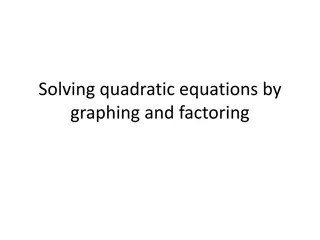Understanding Graphing Techniques and Data Interpretation
Exploring the significance of graphs in interpreting data, this content covers topics like graphing techniques, interpreting trends, variables, types of data relationships, and trend lines. Learn how to identify patterns, understand independent and dependent variables, and recognize positive and negative correlations in graphs.
Download Presentation

Please find below an Image/Link to download the presentation.
The content on the website is provided AS IS for your information and personal use only. It may not be sold, licensed, or shared on other websites without obtaining consent from the author. Download presentation by click this link. If you encounter any issues during the download, it is possible that the publisher has removed the file from their server.
E N D
Presentation Transcript
Graphing Techniques and Interpreting Graphs
Learning Objectives I can explain the reasons/functions for using graphs. I can interpret data on a scientific graph I can describe data trends/relationships shown on a graph. I can predict data using interpolation and extrapolation.
Why are graphs important? What is the functions for graphs?
Introduction Introduction A graph of your data allows you to see the following: Trends Shows Relationships between the independent and dependent variables. Shows visual representation of data Patterns
Variables Independent Variable (I.V.) Something the experimenter changes and is placed on the X Axis. Dependent Variable (D.V.) Measured during the experiment and is placed on the Y Axis.
Types of Data Relationships Types of Data Relationships Directly Related Inversely Related
Directly Related or Directly Related or Direct Relationship Direct Relationship IV increases, DV increases or as IV decreases, DV decreases. Positive trend on a graph Math calls this a positive correlation
Inversely Related or Inversely Related or Inverse Relationship Inverse Relationship IV increases, DV decreases or as IV decreases, DV increases. Negative trend on a graph Math calls this a negative correlation
Trend Line or Line of Best Fit Trend Line or Line of Best Fit A line that summarizes the data. This is sometimes called a best-fit line. The line of best fit is drawn so that the points are evenly distributed on either side of the line Data points do not have to be on this line or the line DOES NOT need to go through each point. The data points are NOT connected with a line. It DOES NOT have to go through the origin.
Time vs. Temperature 14 Temperature (K) 12 10 8 6 4 2 0 0 2 4 6 Time (s)
Time vs. Temperature 14 Temperature (K) 12 10 8 6 4 2 0 0 2 4 6 Time (s)
Ways to predict data Ways to predict data Interpolation - Predicting data that is inside the range of data (between 2 existing data points) Extrapolation - Predicting values that are outside of the range of data. Trend line is often extended to make extrapolation easier.
Interpolation Interpolation Predict data that is inside the range of data (between 2 existing data points)
Extrapolation Extrapolation Predicting values that are outside of the range of data. Trend line is often extended to make extrapolation easier.
Example Predict the time at temperature 90. Did you interpolate or extrapolate? Why did you use this process? Temperature (0C) Time (Min)
87min Example Predict the time at temperure 90. Did you interpolate or extrapolate? Why did you use this process? Extrapolate Outside the data Temperature (0C) 87min Time (Min)
Example Predict the temperature at time 30. Did you interpolate or extrapolate? Why did you use this process? Temperature (0C) Time (Min)
280C Example Predict the temperature at time 30. Did you interpolate or extrapolate? Why did you use this process? Interpolate Between 2 Points Temperature (0C) Point 1 28oC Point 2 Time (Min)
Big Ideas Big Ideas Trend line or best fit line A line that summarizes the data. Data points do not need to be on this line. The data points are NOT connected with a line Data Relationships Directly Related IV increases , DV increases ; and vice versa Inversely related IV increases , DV decreases ; and vice versa Data Prediction Interpolation predicting values that are within the range of available data (between existing data points) Extrapolation predicting values that are outside the range of data; a trend line is often extended.























